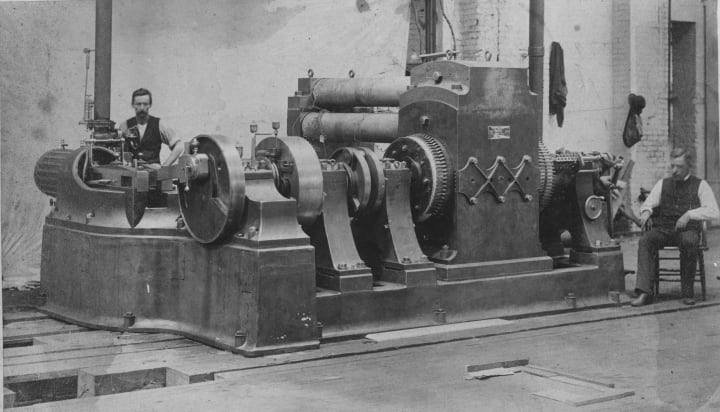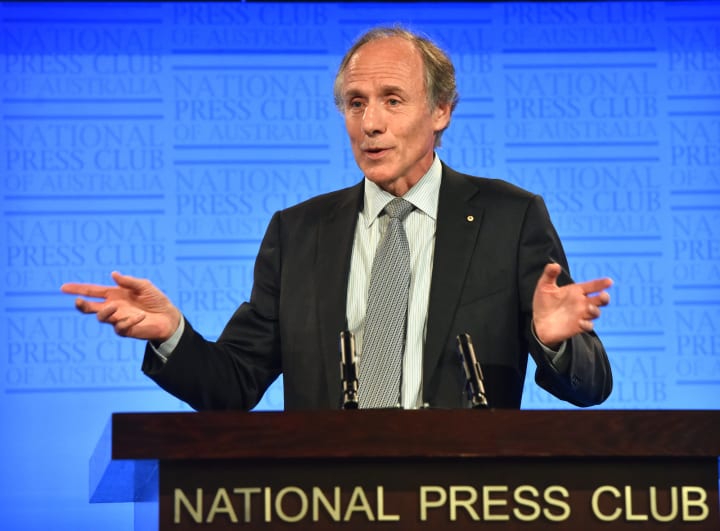The Battery Revolution Has Begun
Our energy system is based on a rickety 19th century concept, but a revolution in energy storage is changing that.

IT WAS THE YEAR the Soviet Union collapsed, Osama bin Laden founded al-Qaeda, and the lauded American physicist Richard Feynman died. Murphy Brown debuted on U.S. television, while at the cinema, Rain Man battled it out with Who Framed Roger Rabbit? and Crocodile Dundee II.
And while it doesn’t have quite such a recognition factor, 1988 was also the year Maria Skyllas-Kazacos, an Australian professor of chemical engineering, obtained a U.S. patent for inventing the vanadium redox battery, or VRB.
VRBs are quite something. Unlike traditional lead-acid batteries of the time, or the lithium-ion wonders of today, they store and convert energy separately. They stockpile electricity as chemical energy in two large tanks filled with electrolytic fluids, which are connected to electrochemical cells.
This allows the amount of electricity stored, and the power discharged, to be handled independently. They can be left unused for long periods with no loss of power; and the electrolyte never catches fire, unlike the more temperamental lithium-ion batteries in smartphones today.
However, VRBs are not compact like those in laptops, which is actually their strength. They’re perfect for large-scale storage: hoarding the energy generated by a wind farm, or warehousing energy for a whole city. And if you want more storage, you just build bigger tanks — there’s seemingly no limit to how big a battery can be.
Even better, the bigger they are, the less they cost per kilowatt/hour of energy stored, and unlike other batteries they can be refuelled by pumping in fresh electrolyte. Once refilled, they respond very quickly, switching from storage to discharge in fractions of a second with efficiency levels of 80%.
Skyllas-Kazacos’s invention should have changed the world — but didn’t. Why? Like many of the most interesting energy storage technologies of the past 30 years, it was largely ignored because the world was still stuck in a 19th century way of thinking about electricity.
Luckily, that’s now changing. A revolution is finally under way for the woefully antiquated, overly complex and rather fragile electricity system the world relies on today.
But to understand why storage technologies like VRBs are only now coming into vogue, you first need to understand how we got into this unholy mess.
WE RELY ON STORAGE every day: stored knowledge in books, stored memories in pictures and stored value in money. But when it comes to energy, we’re back in the stone age, living hand-to-mouth.
Since Thomas Edison built the first power station at the corner of Pearl and Fulton streets in New York’s Lower Manhattan, three blocks from the Brooklyn Bridge, in 1882, electricity has been generated the same way: in real-time, for immediate use.
More than 24 kilometres of insulated copper wiring was laid below ground at 257 Pearl Street, and six massive coal-fired generators — each weighing 30 tonnes — were installed to serve the First District, an area of 650,000 square metres that included the old New York Times building. Within a year, Edison’s 59 customers had grown to 472, and the electricity generating business took off.

The Pearl Street station was also the world’s first electricity grid, and every grid that followed was the same basic design: a centralised power plant distributing energy over a network of high voltage transmission lines, with associated transformers, underground cables or poles and wires. To ensure the power was always on, electricity was produced continuously to meet demand instantaneously.
How do generators know exactly how much is needed? They don’t, because factories and households don’t notify in advance how much they plan to use. So, power stations estimate demand, then generate more than that to ensure enough headroom to cater for sudden increases.
Balancing supply and demand is fraught with danger: produce too little, and the whole network falls over and blackouts ensue; produce too much, and more energy is generated than is needed, and therefore wasted. This, in a nutshell, is the challenge of centralised power plants — one that only became harder and harder as the grid expanded.
It may sound preposterously rickety, but this is still the electricity system of the 21st century. Sure, grid operators now have sophisticated models to anticipate usage, and continuously adjust the output of power plants to meet demand; they’ve developed intricate systems to shunt electricity across the grid in real time to balance supply and use; and they minimise wastage and cost by ranking available generators according to which can satisfy demand fastest and at the lowest cost, gradually moving up the cost scale until demand is fully met. Nevertheless, the system is still riddled with uncertainty, and can teeter on the edge of failure several times a year.
In 2017, Australia’s Chief Scientist, Dr Alan Finkel, told the National Press Club in Canberra that he was in awe of the 5,000-kilometre-long interconnected network that is Australia’s national electricity grid, describing it as one of the most complex machines in the world and “a stupendous feat of engineering”. But, he admitted, “it was designed for a different world” — a world in which electricity flowed in one direction, from centralised generators to far-flung users, and demand rose and fell predictably. “Those days are irrevocably gone, here and around the world,” he added.

He’s right. While the complex engineering that drives the grid in Australia (and every other country) may be impressive, it’s based on a concept that was already outdated — and being overtaken by technological changes — when Australia’s interconnected national grid was completed in 1998.
Disruption was coming from many angles: the growing use of renewable energy, like wind and solar, being connected to the grid, adding intermittency; the rapidly falling prices for solar panels, which triggered a boom in solar rooftop installations and made solar farms viable; and the voracious demand for laptop computers, which accelerated the development (and lowered the cost) of energy-dense batteries like lithium-ion, eventually creating a secondary market for large-scale storage. Meanwhile, computers and high-tech electronics in industry and in homes were changing the way energy was used, unbundling what had for decades been a neat and predictable pattern of usage.
Those effects were just beginning in 1998. Twenty years later, the disruption is so immense, electricity grids are having trouble coping.
Take Australia, for example. In 2018, the number of rooftop solar power generators on Australian homes passed two million, compared with just 20,000 a decade before. There are now, on average, six new household solar installations every minute in the country.
In total, 8,900 gigawatt-hours (GWh) of Australia’s power currently is generated from solar rooftops — more than the 8,000 GWh generated by the Liddell Power Station near Muswellbrook in regional New South Wales, once the biggest power station in Australia. Another 766 GWh of electrical energy was produced by large-scale solar farms (versus zero in 1998) and 12,668 GWh by wind turbines, compared with just eight two decades ago.
That’s a good thing, right? Yes — and no. Australia’s national grid was designed to cater for centralised power from large-scale hydroelectric, coal and gas-fired generators. It was created not just to ensure power was easily transferable from one side of the country to another, but also to drive prices lower. If there were too many plants producing power but not enough being used, prices would fall, encouraging the most expensive generators to drop off the grid. Conversely, spikes in demand did the reverse: pushing prices higher and encouraging more generators online, which eventually lowered prices across the grid.
This worked nicely when competition was between big coal, big gas and big hydro. But solar and wind have become such a low-cost way to produce electricity, and are now so widespread, that they have forced prices lower on the grid — and, paradoxically, higher.

When solar and wind generators are in operation, they are so cheap that large-scale coal and gas cannot compete, so these dial back production or shut down. However, power from renewables is intermittent — it can rise and fall with little warning, such as when winds abate, or clouds diminish the intensity of sunlight falling on solar panels. Hence, if supply falls off suddenly, and demand stays the same, prices on the grid spike up to encourage more generation and avoid blackouts. That brings the big generators back to cash in.
Problem is, these coal and gas behemoths are inflexible; they take from several hours to a whole day to go from standstill to full power. Even when running hot, they cannot easily or economically vary output up or down fast enough to meet sudden peaks in demand, such as during a heatwave.
Because all generators on the Australian grid are paid for the power supplied in five-minute blocks (known as the spot price), the price of electricity sold on the national grid can vary wildly — on rare occasions, as high as A$14,000/MWh, and as low as minus A$1,000/MWh. But prices stabilise over the year. The average spot price in 2018 was around A$111/MWh in South Australia and A$100/ MWh in Victoria, for example.
Nevertheless, it’s obvious that energy storage is the missing link in this whole shebang. It would allow the power generated by any technology — solar, wind, coal, gas — to be amassed when demand is low, and discharged when demand rises.
And it’s not like energy storage isn’t used. Globally, there are 70 dams, with a generating capacity of at least 2,000 MW each, where water is stored then released gradually to drive turbines and generate electricity. But hydroelectricity, while renewable and flexible, is enormously costly (monetarily and environmentally) to build, and limited by geography and access to reliable sources of water. While those 70 dams have a total energy output of more than 1.2 million GWh, they required the flooding of more than 70,000 square kilometres of land to create them.
“There was a huge lack of imagination,” recalls Skyllas-Kazacos of her discussions with industry giants in the 1990s, when she was trying to commercialise the VRB patents she’d taken out for her employer, the University of New South Wales (UNSW). “People in the electricity sector didn’t seem to be aware of what technology was out there. But also, everyone was looking after their own interests, unfortunately. They weren’t looking at the big picture.”

SUDDENLY, EVERYONE’S looking at the big picture. Energy storage is booming: more than 10 battery ‘gigafactories’ are under construction around the world (the ‘giga’ in the name comes from the gigawatt-hours in total production capacity).
Germany’s BMZ has opened Europe’s biggest lithium-ion battery factory southeast of Frankfurt, where the current production of 15 GWh a year for cars, households and grid storage is expected to double. In Sweden, SGF Energy plans to build a factory with a production capacity of 35 GWh a year, while South Korea’s Samsung wants to manufacture up to 2.5 GWh of batteries in Hungary, and compatriot LG Chem is building a lithium-ion battery plant in Poland.
“The tumbling cost of batteries is set to drive a boom in the installation of energy storage systems around the world,” analyst Bloomberg New Energy Finance said in its November 2018 report, Long-Term Energy Storage Outlook. It estimates the global market for new energy storage will double six times, rising to a total of 305 GWh a year by 2030: “This is a similar trajectory to the remarkable expansion that the solar industry went through from 2000 to 2015, in which the share of photovoltaics as a percentage of total generation doubled seven times.”
Here’s the thing: this revolution did not result from a dawning of wisdom across the global electricity industry. Although there have been some notable pioneers in California and Japan over the past 20 years, the industry has largely sat on its hands. No, it was the sudden demand for batteries for electric cars that triggered it.
Specifically, Elon Musk. The co-founder and CEO of Tesla wanted to dramatically scale up production of his snappy electric cars by making them much, much cheaper. Since more than half the cost of the vehicles in 2010 was their energy-dense lithium-ion batteries, he concentrated on these. And Tesla succeeded more quickly than anyone expected, reducing production costs 73% between 2010 and 2014: from US$1,000 per kilowatt-hour (kWh) to US$269 per kWh.
To shave even more costs and get down to the magical US$100 kWh ‘inflection point’ — at which electric cars become cheaper than those powered by fossil fuels — Tesla would need to scale up battery production enormously. So, Musk took a huge bet: he built the world’s biggest battery factory, Tesla’s Gigafactory 1, outside Reno, Nevada.
It is designed to manufacture 150 GWh of battery packs a year by the time it is complete in 2020 — enough for Tesla to make 1.5 million cars annually. But when the factory opened in 2016, Tesla was producing just under 84,000 vehicles. To justify the factory’s eventual US$5 billion cost, and generate revenue while vehicle production was ramped up, his engineers redesigned the vehicle battery packs into household versions, known as Powerwalls, and utility-scale versions, or Powerpacks. These began selling in 2015, and by the following year, production was being scaled up at Gigafactory 1.
So, when South Australia was plunged into darkness by three major blackouts in late 2016 and early 2017, Musk saw the opening for a public relations coup and successfully pitched to build the world’s single biggest battery there in 100 days or it would be free. A 129 MWh lithium-ion battery station was built at the Hornsdale wind farm 220 kilometres north of Adelaide, and went live in December 2017. And it worked.

Within weeks, the coal-fired Loy Yang power plant in regional Victoria tripped and went offline, risking South Australia’s energy supplies. But the Hornsdale battery immediately dispatched 100 MW into the national grid — in the record time of 140 milliseconds. In fact, the speed at which Hornsdale battery has stabilised the grid when other generators failed, plus the extra competition it has brought to the national grid, has played a large part in saving the South Australian government nearly A$33 million so far.
Tesla isn’t the only player in the roaring battery field, as the massive expansion of production by Germany, Sweden and South Korea attests. But it has been the most important catalyst: firstly, in accelerating the introduction of electric vehicles, and secondly, by proving that expensive lithium-ion batteries could be made a whole lot cheaper.
When Tesla launched its first roadster in 2008, it was only the third company producing all-electric cars (as opposed to petrol-electric hybrids like Toyota’s Prius), and it sold 100 that year. Now, there are 40 manufacturers, and almost five million electric cars are on the road. By 2030, this is expected to reach 125 million, representing 50% of new car sales in China and 30% in the European Union, Japan and India. Yet, more than half of today’s manufacturers only entered the market in 2014 — the same year Tesla succeeded in halving the production cost of batteries.
Today, Tesla’s Gigafactory 1 is manufacturing 20 GWh of lithium-ion battery capacity a year — almost as much as the whole world produced in 2012. Another facility is under construction in Shanghai, with plans to build a third one in Europe.
But is lithium-ion the best technology for grid-scale storage?
THE VERY THING that makes lithium-ion batteries so powerful is what makes it possible for them to catch fire or explode. First developed by Sony in 1991, they pack five times more power per kilogram than lead-acid batteries and almost three times as much as a nickel-cadmium. They recharge more quickly, last longer, have a wider temperature range and are made from components with low toxicity.
Their biggest drawback is safety. The electrolyte fluid sitting between the positive and negative electrodes is flammable, and only a thin plastic membrane keeps the two electrodes apart. If overcharged, or if an internal malfunction causes a short circuit, a ‘thermal runaway’ can occur and the batteries ignite. To avoid this, the batteries have a built-in circuit breaker, or current interrupt device, which stops charging when the voltage reaches maximum, the batteries get too hot or their internal pressure is too high. But this too can fail, due to manufacturing faults or bad handling. Which is why, in 2016, the International Civil Aviation Organisation banned lithium-ion battery shipments aboard passenger planes.

Fires can be devastating. In March 2018, a discarded lithium-ion battery ignited at a recycling facility in New York and 44 fire trucks and 198 fire fighters had to be called out to fight the blaze. It burned for two days and shut down four branches of the Long Island railroad for several hours as thick smoke blew onto the tracks.
That doesn’t make electric vehicles with lithium- ion batteries dangerous: after all, conventional cars are powered by flammable petrol that can literally explode. But as the batteries become ubiquitous, their drawbacks will become more visible.
“Lithium-ion was not fundamentally designed for grid-scale storage,” Andrew Chung, founder of the US$200 million Silicon Valley venture fund 1955 Capital, told Renewable Energy World. Even if costs continue to fall, and safety concerns are discounted, lithium-ion batteries still have a limited lifespan. “Utilities and commercial building owners want something that will last 20 years and operate flawlessly,” Chung said.
All batteries degrade over time, becoming less effective the more they are charged and recharged (or cycled). Because lithium-ion batteries are still new, and only recently used for large-scale storage, there are uncertainties about their longevity. A study by the U.S National Renewable Energy Laboratory in 2017 found that commercially available lithium-ion batteries can last 10 years — but only if they’re cycled at 54% of their operating range. NASA, which has used lithium-ion batteries on satellites that need to operate for eight years or more, similarly extends their lifetime by never fully cycling them.
Nevertheless, both the Hornsdale battery and the world’s second largest, the Mira Loma 80 MWh storage facility outside Los Angeles (which both use Tesla’s Powerpacks), are proving adept at overcoming brief spikes in the demand, as well as short-term frequency regulation that would otherwise trip the grid or cause instability problems.
But when it comes to all round storage solutions for the grid, it’s vanadium batteries that have the edge.
A GIANT VANADIUM redox flow battery is undergoing trials in the picturesque German village of Pfinztal, about 50 kilometres south of Heidelberg. Built by engineers at the Fraunhofer Institute for Chemical Technology, it can store and discharge 20 MWh of energy. Connected to a 100-metre-tall wind turbine capable of generating 2 MW, it is being used to test battery materials, design and performance, and simulating VRB operations as part of a national grid.
But it is a minnow compared to what China’s Rongke Power, which was established in 2008 to commercialise VRB technology, is building on the Dalian peninsula, 550 kilometres east of Beijing. A battery complex 40 times bigger and able to store 800 MWh is due to come fully online in 2022.

The battery stacks are being manufactured at Rongke’s new gigafactory, which opened in 2016 and will eventually have a production capacity of 3 GWh a year. And the Dalian complex is just one of almost 30 battery installations being built across China by Rongke, a spin-off from the Dalian Institute of Chemical Physics, a research division of the Chinese Academy of Sciences.
“In vanadium flow batteries, China is leading the world,” says Huamin Zhang, Rongke’s co-founder and chief engineer. “They are an attractive commercial proposition because they are safe and environmentally friendly, use recyclable electrolytes, have a long cycle life, and last for more than 15 years.”
Skyllas-Kazacos first met Zhang in 2006, when the Dalian Institute of Chemical Physics — where Zhang was director of energy storage — began making enquiries about VRBs. “We noticed that there was a lot of interest from China in our patents and what we had been doing in Australia,” she recalls. “He really took it on and got a lot of funding from the Chinese government.”
UNSW licensed the VRB technology to various companies in the 1990s, and large demonstration projects were built in Japan and California. But it took the expiry of the university’s original patents in 2006 for interest in VRBs to really take off.
Skyllas-Kazacos received a flurry of invitations to international conferences in the years that followed, serving a stint as a distinguished lecturer at the U.S Department of Energy’s Pacific Northwest National Laboratories in Washington State in 2009. There, she met Z. Gary Yang, then head of energy storage research, who became excited by the potential for vanadium.
Yang turned his team’s attention to VRBs, and over the next few years boosted their energy density by 70%, overcame temperature stability issues and lowered costs. In 2012, he and a colleague left the Department of Energy to establish UniEnergy Technologies, which began developing prototypes. With a staff of 60, the company has since installed 80 MWh of commercial capacity in VRBs and, in 2016, became a development partner with Rongke Power.

It is just one of six U.S companies selling VRBs, with others operating in Britain, Japan, Australia and Austria. In Germany, engineering giant ThyssenKrupp has launched a new VRB design with giant cells and 1 MW stacks that are modular and can be expanded into hundreds of megawatts. Industry analysts are forecasting annual demand for VRB systems to rise to between 18,000 and 27,500 MWh by 2027, or about 25% of the energy storage market.
“This technology is starting to achieve cost parity with lithium-ion at a systems level after only five years of development — compared with the more than 25 years that lithium-ion cells have been in production,” Vincent Sprenkle, a lead researcher at Pacific Northwest National Laboratory, told a U.S. Senate hearing in October 2017. The lab still collaborates with UniEnergy, and Sprenkle said he believes VRB costs could be lowered by another 50%.
Yang is convinced vanadium will trounce lithium-ion in grid-scale storage. “They have longer lifetimes, can be scaled up more easily, and can operate day in, day out, with no significant performance loss for 20 years or more,” he says. And he believes Rongke Power’s VRB complex will prove a game changer. “It will be the largest battery installation in the world, and the Dalian site is just one of several big VRB installations being built in China. And there are another 30 VRB projects in 11 countries either deployed or under construction.”
For her part, Skyllas-Kazacos is delighted to see the rebirth of interest in VRBs, more than 34 years after she first started working with the silvery-grey metal that is vanadium. “For years I was very frustrated and very upset. I got over it,” she says. “Now, I’m just happy that it’s finally here. Our work is being acknowledged and being put to good use. It’s great to see that the time for vanadium batteries has come.”
Like this story? Please click the ♥︎ below, or send me a tip. And thanks 😊
About the Creator
Wilson da Silva
Wilson da Silva is a science journalist in Sydney | www.wilsondasilva.com | https://bit.ly/3kIF1SO






Comments
There are no comments for this story
Be the first to respond and start the conversation.